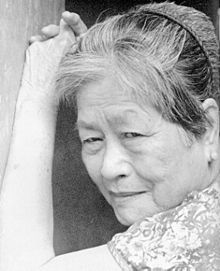By PABLO A. TARIMAN
 IF Lola Rosa were alive, she would have been 85 today.
IF Lola Rosa were alive, she would have been 85 today.
One of the unrealized film projects of Marilou Diaz-Abaya was one touching on the story of Ma. Rosa Luna Henson, known as Lola Rosa, the first Filipina to tell her story as a comfort woman for the Imperial Japanese Army during World War II.
In October 1992, a Philippine News and Features dispatch said opening up the issue of World War II comfort women was like discovering skeletons in the royal closet of Ilongos. It also acknowledged that the only indirect reference to comfort women in Panay Island was the novel of Stevan Javellana, “Without Seeing the Dawn.”
In the same news dispatch, Javellana’s aunt, Caledonia Solivia, then 86, confirmed that the event and places in the novel are true but the names of people have been changed.
If this is true, the first documentation on the life of comfort women actually can be found in this superb Javellana novel published in the United States in 1947.Hence the story of comfort women was written (although in a work of fiction) as early as 65 years ago.
Re-reading “Without Seeing the Dawn,” one finds a beautiful recollection of life in the Philippine islands before World War II and after.
But the most searing part of the book is the last part called “Night” where a once idyllic village is ravished by Japanese invaders. Here you see the brutalization of the Filipinos as simple folks and the numbing transformation that followed.
Here a housewife and mother named Lucing is gang-raped by Japanese soldiers, a maiden named Flora is defiled under the horror-stricken eyes of her lover Lucio whose genital was dismembered.
Author Javellana, in his foreword to the book, said the characters in his novel are fictitious and that any resemblance to real persons living or dead was wholly accidental and unintentional.
However, the Philippine Center of Investigative Journalism account of Henson who was raped and taken to a comfort house in Angeles City bears resemblance to the main character in the Javellana novel.
Born in Pasay City on December 5, 1927, Rosa was 14 years old when the war broke out and the Philippines was occupied by the Japanese.
She was caught by the Japanese soldiers while she was gathering firewood. She was raped. She joined the Hukbo ng Bayan Laban sa Hapon (HUKBALAHAP) and was arrested again at a checkpopint in Angeles. She was taken to garrison and forced tob e a comfort woman.
 Javellana’s novel even confirmed the presence of comfort women.
Javellana’s novel even confirmed the presence of comfort women.
In the chapter called “The Bad Woman,” author Javellana described the Japanese headquarters thus: “The hotel had once been a respectable one. But the Japanese had set it up as a house of prostitution for their soldiers… The buxom, full-bosomed Japanese and Korean women with cherry pink cheeks, smiled enigmatically and laughed and talked quietly, breathing the drowsy afternoon air.”
The comfort women in the novel were indeed pathetic figures of destiny but two of them – Rosing and Alicia — had set out to exact their revenge. Setting fire on the Japanese ammunition camps as instructed by their guerrilla boyfriends, the women in the Javellana novel looked like the avenging women in the Brocka movies.
One such character named Alicia had is described thus with this dialogue: “I have forgotten to pray. Did you ever know a harlot who prayed for herself? But I did pray once and that answer was when I saw him (her lover).
“Then her face became set and harsh and, somehow, as a sneer broke her mouth. ‘I hate men,’ she spat out the words,’ but I will have my revenge. I have the beginnings of a disease. It gives me joy to know that I am giving it to everyone who comes to share my bed’ she laughed wickedly as if it were some ghastly joke.”
Book lovers from both the old and new generation can learn a lot from this book.
The well-written book is proof that first-rate Filipino writers were at their best in the 1940s.
The New York Times called the Javellana novel a “story at once tender and brutal, charged with love and yet muffled by violence…”
Eminent poet Jose Garcia Villa called it “a Philippine classic.”
But because it brought to the realm of literature the true-to-life stories of Filipino comfort women, one tend to agree with National Artist Francisco Arcellana that from the viewpoint of art, “Without Seeing the Dawn” is the first Filipino novel in English.


